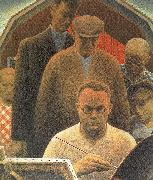Wholesale Oil Painting No Minimum |
|||||||||||
|
|
|||||||||||

|
|||||||||||
|
|
|
||||||||
Grant Wood1891-1942 Grant Wood Locations His family moved to Cedar Rapids after his father died in 1901. Soon thereafter he began as an apprentice in a local metal shop. After graduating from Washington High School (Cedar Rapids, Iowa) , Wood enrolled in an art school in Minneapolis in 1910, and returned a year later to teach in a one-room schoolhouse. In 1913 he enrolled at the School of the Art Institute of Chicago and did some work as a silversmith. From 1920 to 1928 he made four trips to Europe, where he studied many styles of painting, especially impressionism and post-impressionism. But it was the work of Jan Van Eyck that influenced him to take on the clarity of this new technique and to incorporate it in his new works. From 1924 to 1935 Wood lived in the loft of a carriage house that he turned into his personal studio at "5 Turner Alley" (the studio had no address until Wood made one up himself). In 1932, Wood helped found the Stone City Art Colony near his hometown to help artists get through the Great Depression. He became a great proponent of regionalism in the arts, lecturing throughout the country on the topic. Wood taught painting at the University of Iowa's School of Art beginning in 1934. During that time, he supervised mural painting projects, mentored students, produced a variety of his own works, and became a key part of the University's cultural community. On February 12, 1942, one day before his 51st birthday, Wood died at the university hospital of liver cancer. When Wood died, his estate went to his sister, Nan Wood Graham, the woman portrayed in American Gothic. When she died in 1990, her estate, along with Wood's personal effects and various works of art, became the property of the Figge Art Museum in Davenport, Iowa. Wood was an active painter from an extremely young age until his death, and although he is best known for his paintings, he worked in a large number of media, including ink, charcoal, ceramics, metal, wood and found objects. Throughout his life he hired out his talents to many Iowa-based businesses as a steady source of income. This included painting advertisements, sketching rooms of a mortuary house for promotional flyers and, in one case, designing the corn-themed decor (including chandelier) for the dining room of a hotel. In addition, his 1928 trip to Munich was to oversee the making of the stained-glass windows he had designed for a Veterans Memorial Building in Cedar Rapids. He again returned to Cedar Rapids to teach Junior High students after serving in the army as a camouflage painter. |
||||||||
|
|
||||||||
Return From Bohemia
Return From Bohemia Painting ID:: 4601 |
1935
The Regis Collection 1935 The Regis Collection |
|||||||
|
|
||||||||
|
Grant Wood 1891-1942 Grant Wood Locations His family moved to Cedar Rapids after his father died in 1901. Soon thereafter he began as an apprentice in a local metal shop. After graduating from Washington High School (Cedar Rapids, Iowa) , Wood enrolled in an art school in Minneapolis in 1910, and returned a year later to teach in a one-room schoolhouse. In 1913 he enrolled at the School of the Art Institute of Chicago and did some work as a silversmith. From 1920 to 1928 he made four trips to Europe, where he studied many styles of painting, especially impressionism and post-impressionism. But it was the work of Jan Van Eyck that influenced him to take on the clarity of this new technique and to incorporate it in his new works. From 1924 to 1935 Wood lived in the loft of a carriage house that he turned into his personal studio at "5 Turner Alley" (the studio had no address until Wood made one up himself). In 1932, Wood helped found the Stone City Art Colony near his hometown to help artists get through the Great Depression. He became a great proponent of regionalism in the arts, lecturing throughout the country on the topic. Wood taught painting at the University of Iowa's School of Art beginning in 1934. During that time, he supervised mural painting projects, mentored students, produced a variety of his own works, and became a key part of the University's cultural community. On February 12, 1942, one day before his 51st birthday, Wood died at the university hospital of liver cancer. When Wood died, his estate went to his sister, Nan Wood Graham, the woman portrayed in American Gothic. When she died in 1990, her estate, along with Wood's personal effects and various works of art, became the property of the Figge Art Museum in Davenport, Iowa. Wood was an active painter from an extremely young age until his death, and although he is best known for his paintings, he worked in a large number of media, including ink, charcoal, ceramics, metal, wood and found objects. Throughout his life he hired out his talents to many Iowa-based businesses as a steady source of income. This included painting advertisements, sketching rooms of a mortuary house for promotional flyers and, in one case, designing the corn-themed decor (including chandelier) for the dining room of a hotel. In addition, his 1928 trip to Munich was to oversee the making of the stained-glass windows he had designed for a Veterans Memorial Building in Cedar Rapids. He again returned to Cedar Rapids to teach Junior High students after serving in the army as a camouflage painter. Return from Bohemia mk52 1935 Pastel on paper 62.9x50.8cm Davenport Museum of Art Iowa |
||||||||
|
|
||||||||
|
Prev Next
|
||||||||
|
|
||||||||
|
Related Paintings to Grant Wood :. |
||||||||
|
|
||||||||
|
CONTACT US |

